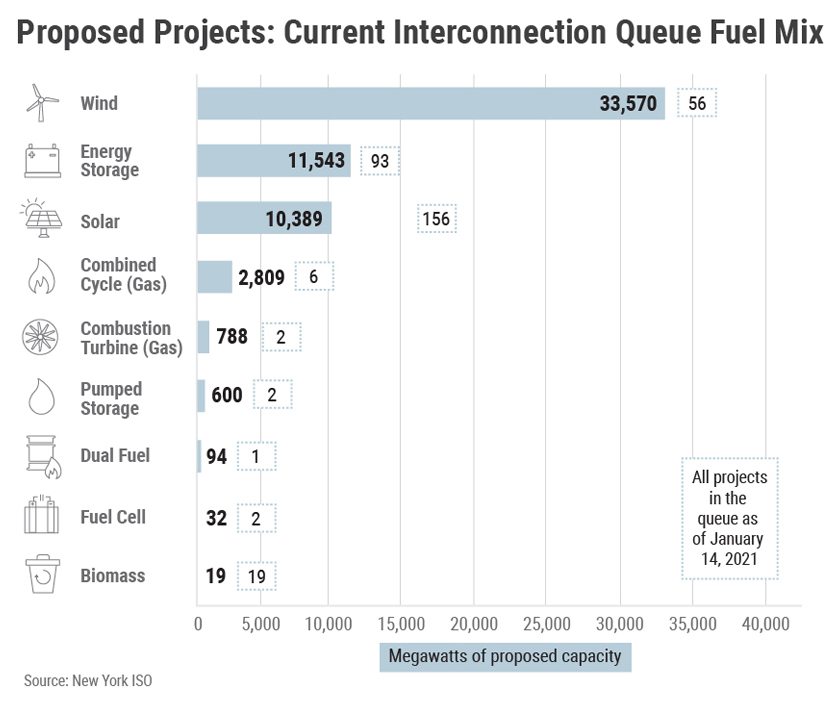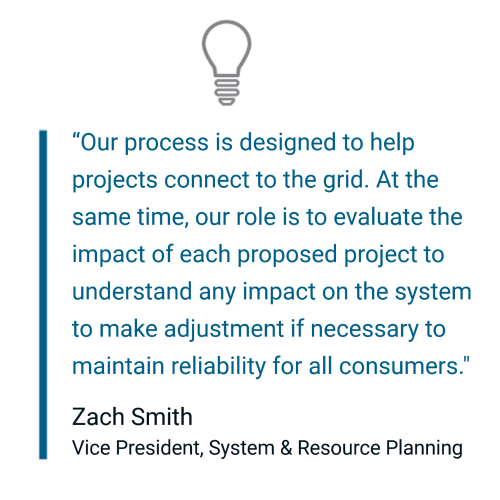Our Interconnection Queue Shows Unprecedented Growth of Clean Energy Investment in NY

The year 2040, when New York State is required to have a zero-emission grid, may seem to be a long way away. But work has already started to develop some of the clean energy projects that will help us reach the Climate Leadership and Community Protection Act mandate.
Today, we are seeing an unprecedented number of clean energy projects proposed in New York. The combined wind, solar and battery storage projects currently in our “Interconnection Queue” have more energy capacity than all the current in-state generation resources serving the grid today.
What is the Interconnection Queue? “Interconnection” refers to the process of connecting new energy resources to the electric grid. Thus, the Interconnection Queue is a list of transmission and generation projects that are currently proposed and seeking to join the grid.
The vast majority of projects in the queue today are either renewable or energy storage resources.
For example, proposed projects include:
- 156 solar power resources
- 93 energy storage resources
- 56 wind power resources

Today’s queue is unlike any we have seen before. In past years, conventional generation resources dominated the queue. From the late 1990s until recently, natural gas-fired and dual-fuel generators typically sought access to the grid, with wind resources growing in the upstate and western regions. That trend began to change with public policy requirements for renewable energy production.
Since then, renewables and battery storage proposals have grown exponentially. These projects are typically smaller in terms of installed capacity than gas-fired generation and often located further away from load centers. For more on the “Tale of Two Grids,” see this blog.
And, as NYISO’s Climate Change Study has shown, renewable energy like solar and wind are intermittent, with their output based on weather and time of day, and will require supplemental energy from “flexible” generation and energy storage resources to keep the grid in balance.
To be approved for interconnection, each project must undergo three studies that examine various aspects of how they would impact the grid, as well as costs of grid upgrades to accommodate the new resource. Not all proposed projects will be realized.

These proposed projects would provide a substantial amount of power to New York consumers. For instance, the wind power projects in the queue currently total an additional 33,600 megawatts (MW). By comparison, today’s grid currently features about 38,500 MW of total in-state generation capacity from various sources, including about 2,000 MW of wind power.
Those proposed wind projects include a number of offshore wind projects, which require significant investment. The projects could take many years to be completed and connected.
Additional clean energy production in the state will be delivered by growth in solar power. The queue now includes proposed projects representing 10,400 MW.
And these renewable resources could be supplemented by as much as 11,500 MW of proposed energy storage resources (ESRs). ESRs will play a huge role on the clean energy grid by storing energy when renewable output is abundant and distributing it when needed. With an increased reliance on resources dependent on weather, this will help maintain reliability by continuing to fill power needs when the sun is not shining or the air is still.
The interconnection study process is resource-intensive and exacting, but the result helps ensure the reliable operation of the electric grid while meeting the state’s mandates.
For more about how we are addressing a zero-emissions grid with market-based solutions, visit the 2040 Power Grid webpage.

